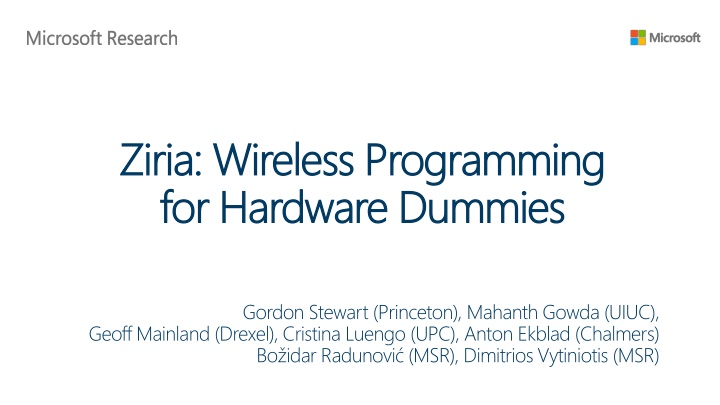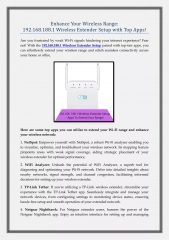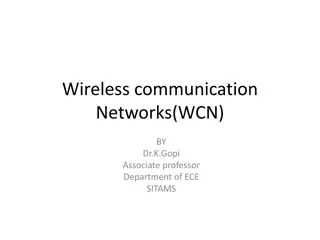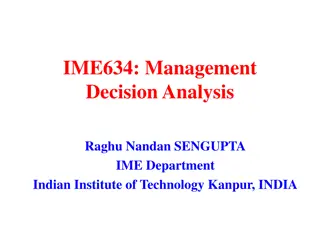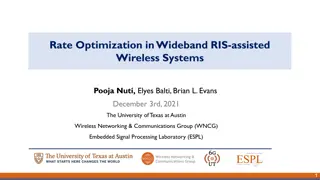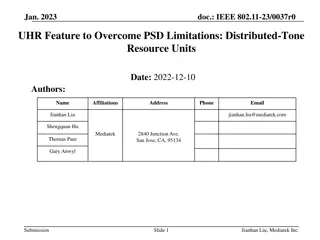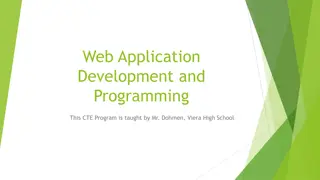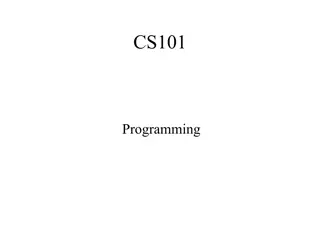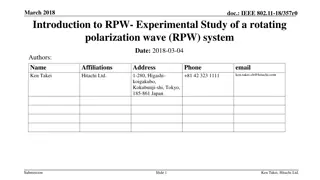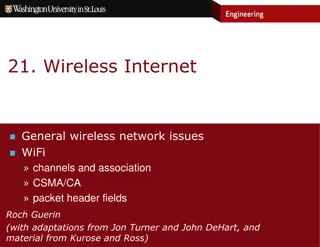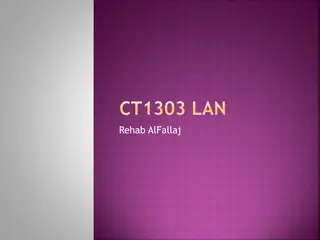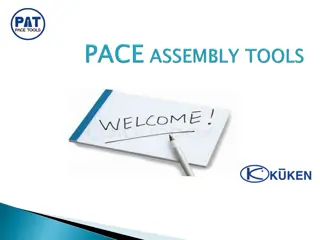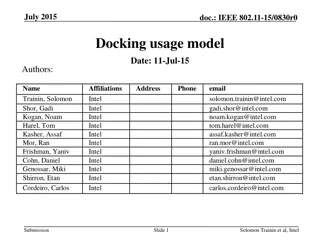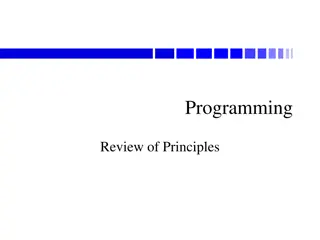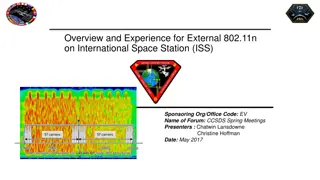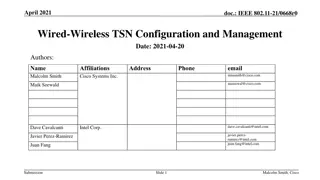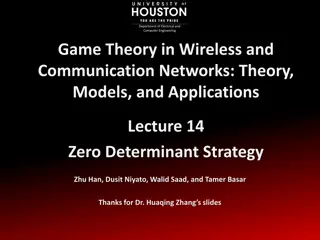Enhancing Wireless Programming Tools for Improved Development Efficiency
The article discusses the challenges faced by wireless researchers in current programming tools, highlighting issues with CPU and FPGA platforms. It explores the need for better tools to address manual optimizations, code portability, and innovation hurdles in wireless programming for modern technologies like IoT and 5G.
Uploaded on Sep 18, 2024 | 3 Views
Download Presentation

Please find below an Image/Link to download the presentation.
The content on the website is provided AS IS for your information and personal use only. It may not be sold, licensed, or shared on other websites without obtaining consent from the author.If you encounter any issues during the download, it is possible that the publisher has removed the file from their server.
You are allowed to download the files provided on this website for personal or commercial use, subject to the condition that they are used lawfully. All files are the property of their respective owners.
The content on the website is provided AS IS for your information and personal use only. It may not be sold, licensed, or shared on other websites without obtaining consent from the author.
E N D
Presentation Transcript
Ziria: Wireless Programming Ziria: Wireless Programming for Hardware Dummies for Hardware Dummies Gordon Stewart (Princeton), Mahanth Gowda (UIUC), Geoff Mainland (Drexel), Cristina Luengo (UPC), Anton Ekblad (Chalmers) Bo idarRadunovi (MSR), Dimitrios Vytiniotis (MSR)
Layout Motivation Motivation Programming Language Compilation and Execution Platform Conclusions 2
Motivation Lots of innovation in PHY/MAC design IoT, 5G, distributed/massive MIMO, DSA/TVWS Popular experimental platform: USRP Relatively easy to program but slow, no real network deployment Modern wireless PHYs require high-rate DSP Real-time platforms [SORA, WARP , ] Achieve protocol processing requirements, difficult to program, no code portability, lots of low-level hand-tuning 3
Hardware Platforms FPGA: Programmer deals with hardware issues WARP, Airblue CPUs: SORA [MSR Asia], USRP SORA was a huge breakthrough, design of RX/TX with PCI interface, 16Gbps throughput, ~ s latency Very efficient C++ library We build on top of SORA Many other options now available: E.g. http://myriadrf.org/ 4
Issues for wireless researchers CPU platforms (e.g. SORA) Manual vectorization, CPU placement Cache / data sizing optimizations FPGA platforms (e.g. WARP) Latency-sensitive design, difficult for new students/researchers to break into Portability/readability Manually highly optimized code is difficult to read and maintain Also: practically impossible to target another platform Difficulty in writing and reusing code hampers innovation 5
What is wrong with current programming tools? 6
Current SDR Software Tools FPGA-based: Simulink, LabView (graphical interface), AirBlue/BlueSpec (higher level lang.) CPU-based: C/C++/Python GnuRadio, SORA Control and data separation CodiPhy [U. of Colorado], OpenRadio [Stanford]: Specialized languages (DSL): Stream processing languages: StreamIt [MIT] DSLs for DSP/arrays, Feldspar [Chalmers]: we put more emphasis on control For building efficient DSP algorithms, e.g. Spiral 7
So far, main focus on data flow PHY design is a sequence of signal processing Many efficient DSP tools and libraries available Volk, Sora, Spiral How to connect these blocks? LTE Example: Few basic building blocks (FFT/IFFT, Viterbi/Turbo decoder, vector operations) 400 pages describing how to connect these blocks This talk (and Ziria) focuses on composing signal processing blocks and expressing control flow 8
Issues with control flow Programming abstraction is tied to execution model Programmer has to reason about how the program will be executed/optimized while writing the code Shared state Low-level optimization Verbose programming We next illustrate on Sora code examples (other platforms are have similar problems) 9
How do we execute WiFi RX on CPU? Radio input removeDC Packet start Channel info Detect Carrier Channel Estimation Invert Channel Packet info Decode Header Decode Packet Output to MAC 10
Limited code reusability Implicit assumptions on control flow: Sora: control encoded in state GnuRadio: control encoded in data stream Can vary across components Unclear data and control flow separation: Resetting whoever* is downstream *we don t know who that is when we write this component void Reset() { Next0()->Reset(); // No need to reset all path, just reset the path we used in this frame switch (data_rate_kbps) { case 6000: case 9000: Next1()->Reset(); break; case 12000: case 18000: Next2()->Reset(); break; case 24000: case 36000: Next3()->Reset(); break; case 48000: case 54000: Next4()->Reset(); break; } } 11
Shared state static inline void CreateDemodGraph11a_40M (ISource*& srcAll, ISource*& srcViterbi, ISource*& srcCarrierSense) { CREATE_BRICK_SINK (drop, TDropAny, BB11aDemodCtx ); CREATE_BRICK_SINK (fsink, TBB11aFrameSink, BB11aDemodCtx ); CREATE_BRICK_FILTER (desc, T11aDesc, BB11aDemodCtx, fsink );typedef T11aViterbi <5000*8, 48, 256> T11aViterbiComm; CREATE_BRICK_FILTER (viterbi,T11aViterbiComm::Filter, BB11aDemodCtx, desc ); CREATE_BRICK_FILTER (vit0, TThreadSeparator<>::Filter, BB11aDemodCtx, viterbi); // 6M CREATE_BRICK_FILTER (di6, T11aDeinterleaveBPSK, BB11aDemodCtx, vit0 ); CREATE_BRICK_FILTER (dm6, T11aDemapBPSK::filter, BB11aDemodCtx, di6 ); CREATE_BRICK_SINK (plcp, T11aPLCPParser, BB11aDemodCtx ); CREATE_BRICK_FILTER (sviterbik, T11aViterbiSig, BB11aDemodCtx, plcp ); CREATE_BRICK_FILTER (dibpsk, T11aDeinterleaveBPSK, BB11aDemodCtx, sviterbik ); CREATE_BRICK_FILTER (dmplcp, T11aDemapBPSK::filter, BB11aDemodCtx, dibpsk ); CREATE_BRICK_DEMUX5 ( sigsel,TBB11aRxRateSel, BB11aDemodCtx,dmplcp, dm6, dm12, dm24, dm48 ); CREATE_BRICK_FILTER (pilot, TPilotTrack, BB11aDemodCtx, sigsel );CREATE_BRICK_FILTER (pcomp, TPhaseCompensate, BB11aDemodCtx, pilot ); CREATE_BRICK_FILTER (chequ, TChannelEqualization, BB11aDemodCtx, pcomp ); CREATE_BRICK_FILTER (fft, TFFT64, BB11aDemodCtx, chequ );; CREATE_BRICK_FILTER (fcomp, TFreqCompensation, BB11aDemodCtx, fft ); CREATE_BRICK_FILTER (dsym, T11aDataSymbol, BB11aDemodCtx, fcomp ); CREATE_BRICK_FILTER (dsym0, TNoInline, BB11aDemodCtx, dsym ); Shared state 12
Domain-specific optimizations (LUT) ? struct _init_lut { void operator()(uchar (&lut)[256][128]) { int i,j,k; uchar x, s, o; for ( i=0; i<256; i++) { for ( j=0; j<128; j++) { x = (uchar)i; s = (uchar)j; o = 0; for ( k=0; k<8; k++) { Hand-written bit-fiddling code to create lookup tables for specific computations that must run very fast uchar o1 = (x ^ (s) ^ (s >> 3)) & 0x01; s = (s >> 1) | (o1 << 6); o = (o >> 1) | (o1 << 7); x = x >> 1; } lut [i][j] = o; } } } } 13
Verbosity DEFINE_LOCAL_CONTEXT(TBB11aRxRateSel, CF_11RxPLCPSwitch, CF_11aRxVector ); template<TDEMUX5_ARGS> class TBB11aRxRateSel : public TDemux<TDEMUX5_PARAMS> { CTX_VAR_RO (CF_11RxPLCPSwitch::PLCPState, plcp_state ); CTX_VAR_RO (ulong, data_rate_kbps ); // data rate in kbps public: .. public: REFERENCE_LOCAL_CONTEXT(TBB11aRxRateSel); STD_DEMUX5_CONSTRUCTOR(TBB11aRxRateSel) BIND_CONTEXT(CF_11RxPLCPSwitch::plcp_state, plcp_state) BIND_CONTEXT(CF_11aRxVector::data_rate_kbps, data_rate_kbps) {} - Host language is not specialized, so often verbose - Hinders fast prototyping - Scrambler: 90 lines in Sora (C++), 20 lines in Ziria 14
My Own Frustrations Implemented several PHY algorithms in FPGA Never been able to reuse them: Complexity of interfacing (timing and precision) was higher than rewriting! Implemented several PHY algorithms in Sora Better reuse but still difficult Spent 2h figuring out which internal state variable I haven t initialized when borrowed a piece of code from other project. We need tools to allow us to write reusable code and incrementally build ever more complex systems! 15
Our plan for improving this situation New wireless programming platform 1. Code written in a high-level domain-specific language that allows fast prototyping and code reuse 2. Compiler deals with low-level code optimization and produces code that satisfies timing requirements of modern PHYs 3. Same code compiles on different platforms (not there just yet!) Challenges 1. Design PL abstractions that are intuitive and expressive 2. Design efficient compilation schemes (to multiple platforms) 16
Why (New) Domain Specific Language? Benefits of language: Language design captures specifics of the task This enables compiler to optimize better What is special about wireless 1. that affects abstractions: large degree of separation b/w data and control Data processing elements: FFT/IFFT, Coding/Decoding, Scrambling/Descrambling Predictable execution and performance, independent of data Control flow elements: Header processing, rate adaptation 2. that affects compilation: need high-throughput stream processing Need to process millions of samples per second 17
Layout Motivation Programming Language Programming Language Compilation and Execution Platform Conclusions 18
Ziria: A 2-layer design Lower layer Imperative C-like code for manipulating bits, bytes, arrays, etc. NB: You can plug-in any C function in this layer Higher layer A monadic language for specifying and staging stream processors Enforces clean separation between control and data flow, clean state semantics Runtime implements low-level execution model Monadic pipeline staging language facilitates aggressive compiler optimizations 19
Ziria: control-aware stream abstractions inStream (a) inStream (a) outControl (v) t c outStream (b) outStream (b) A stream transformer t, of type: ST T a b A stream computer c, of type: ST (C v) a b 20
Staging a pipeline, in diagrams Vertical composition (along data path -- arrows ) T C c1 t2 v repeat { v <- (c1 >>> t1) ; t2(v) >>> t3 } t1 t3 Horizontal composition (along control path -- monads ) 21
Running example: WiFi Scrambler let comp scrambler() = var scrmbl_st: arr[7] bit := {'1,'1,'1,'1,'1,'1,'1}; var tmp: bit; var y:bit; repeat seq { x <- take; do { tmp := (scrmbl_st[3] ^ scrmbl_st[0]); scrmbl_st[0:5] := scrmbl_st[1:6]; scrmbl_st[6] := tmp; y := x ^ tmp; }; tmp emit y } in ... 22
Start defining computational method let comp scrambler() = var scrmbl_st: arr[7] bit := {'1,'1,'1,'1,'1,'1,'1}; var tmp: bit; var y:bit; repeat seq { x <- take; do { tmp := (scrmbl_st[3] ^ scrmbl_st[0]); scrmbl_st[0:5] := scrmbl_st[1:6]; scrmbl_st[6] := tmp; y := x ^ tmp; }; emit y } in <rest of the code> End defining computational method 23
Local variables let comp scrambler() = var scrmbl_st: arr[7] bit := {'1,'1,'1,'1,'1,'1,'1}; var tmp: bit; var y:bit; Types: - Bit - Array of bits repeat seq { x <- take; do { tmp := (scrmbl_st[3] ^ scrmbl_st[0]); scrmbl_st[0:5] := scrmbl_st[1:6]; scrmbl_st[6] := tmp; y := x ^ tmp; }; Constants emit y } in ... 24
let comp scrambler() = var scrmbl_st: arr[7] bit := {'1,'1,'1,'1,'1,'1,'1}; var tmp: bit; var y:bit; Special-purpose computers: repeat seq { x <- take; do { tmp := (scrmbl_st[3] ^ scrmbl_st[0]); scrmbl_st[0:5] := scrmbl_st[1:6]; scrmbl_st[6] := tmp; y := x ^ tmp; }; emit y } in ... 25
let comp scrambler() = var scrmbl_st: arr[7] bit := {'1,'1,'1,'1,'1,'1,'1}; var tmp: bit; var y:bit; repeat seq { x <- take; do { tmp := (scrmbl_st[3] ^ scrmbl_st[0]); scrmbl_st[0:5] := scrmbl_st[1:6]; scrmbl_st[6] := tmp; y := x ^ tmp; }; Imperative (C/Matlab-like) code: emit y } in ... 26
let comp scrambler() = var scrmbl_st: arr[7] bit := {'1,'1,'1,'1,'1,'1,'1}; var tmp: bit; var y:bit; repeat repeat seq { x <- take; x y take do emit do { tmp := (scrmbl_st[3] ^ scrmbl_st[0]); scrmbl_st[0:5] := scrmbl_st[1:6]; scrmbl_st[6] := tmp; y := x ^ tmp; }; Computers and transformers emit y } in ... 27
Whole program read >>> do_something >>> write Reads and writes can come from RF, IP , file, dummy 28
Computation language primitives Define control flow Two groups: Transformers Computers 29
Transformers Map: Repeat let f(x : int) = var y : int = 42; y := y + 1; return (x+y); in let comp f(x : int) = x <- take; if (x > 0) then emit 1 in read >>> map f >>> write read >>> repeat f >>> write 30
Computers While: If-then-else: while (!crc > 0) { x <- take; do {crc = search(x);} } if (rate == CR_12) then emit enc12(x); else emit enc23(x); Also: take, emit, for 31
Putting it all together WiFi receiver let comp Decode(h : struct HeaderInfo) = let comp receiver() = DemapLimit(0) >>> seq { det <- detectSTS() (if (h.modulation == M_BPSK) then ; params <- LTS(det.shift) DemapBPSK() >>> DeinterleaveBPSK() ; DataSymbol(det.shift) >>> else if (h.modulation == M_QPSK) then FFT() >>> DemapQPSK() >>> DeinterleaveQPSK() ChannelEqualization(params) >>> else ...) -- QAM16, QAM64 cases PilotTrack() >>> >>> Viterbi(h.coding, h.len*8 + 8) GetData() >>> >>> scrambler() receiveBits() } in let comp detectSTS() = in removeDC() >>> cca() read >>> repeat{ receiver() } >>> write in let comp receiveBits() = seq { h <- DecodePLCP() ; Decode(h) >>> check_crc(h.len) } 32 in
Function Expression language - example let build_coeff(pcoeffs:arr[64] complex16, ave:int16, delta:int16) = var th:int16; Array (equivalent to [64-26:64]) th := ave - delta * 26; for i in [64-26, 26] { pcoeffs[i] := complex16{re=cos_int16(th);im=-sin_int16(th)}; th := th + delta }; th := th + delta; for i in [1,26] { pcoeffs[i] := complex16{re=cos_int16(th);im=-sin_int16(th)}; th := th + delta } in Fixed-point complex numbers External C function 33
Layout Motivation Programming Language Compilation and Execution Platform Compilation and Execution Platform Conclusions 34
Compilation High-level view Expression language -> C code Computation language -> Execution model Numerous optimizations on the way: Vectorization Lookup tables Conventional optimizations: Folding, inlining, 35
Execution model: How to execute code? Radio input removeDC Packet start Channel info Detect Carrier Channel Estimation Invert Channel Packet info removeDC() >>> { pktStart <- detectCarrier() ; chInfo <- chEstim(pktStart) ; invertChan(chInfo) >>> {decodeHdr(); decodePkt()} } Decode Header Decode Packet Output to MAC 36
Runtime B1 Actions: Return values: tick() YIELD YIELD (data_val) tick() process(x) B2 SKIP DONE process(x) DONE (control_val) Q: Why do we need ticks? A: Example: emit 1; emit 2; emit 3
How about performance? let comp test1() = repeat{ (x:int) <- take; emit x + 1; } in (((read >>> let auto_map_6(x: int32) = x + 1 in {map auto_map_6}) >>> let auto_map_7(x: int32) = x + 1 in {map auto_map_7}) >>> write) read[int] >>> test1() >>> test1() >>> write[int] buf_getint32(pbuf_ctx, &__yv_tmp_ln10_7_buf); __yv_tmp_ln11_5_buf = auto_map_6_ln2_9(__yv_tmp_ln10_7_buf); __yv_tmp_ln12_3_buf = auto_map_7_ln2_10(__yv_tmp_ln11_5_buf); buf_putint32(pbuf_ctx, __yv_tmp_ln12_3_buf); 38
Type-preserving transformations let block_VECTORIZED (u: unit) = var y: int; repeat let vect_up_wrap_46 () = var vect_ya_48: arr[4] int; (vect_xa_47 : arr[4] int) <- take1; __unused_174 <- times 4 (\vect_j_50. (x : int) <- return vect_xa_47[0*4+vect_j_50*1+0]; __unused_1 <- return y := x+1; return vect_ya_48[vect_j_50*1+0] := y); emit vect_ya_48 in vect_up_wrap_46 (tt) Dataflow graph iteration converted to tight loop! In this case we got x3 speedup let block_VECTORIZED (u: unit) = var y: int; repeat let vect_up_wrap_46 () = var vect_ya_48: arr[4] int; (vect_xa_47 : arr[4] int) <- take1; emit let __unused_174 = for vect_j_50 in 0, 4 { in vect_ya_48 in vect_up_wrap_46 (tt) let x = vect_xa_47[0*4+vect_j_50*1+0] in let __unused_1 = y := x+1 in vect_ya_48[vect_j_50*1+0] := y } 39
Vectorization Idea: batch processing over multiple data items repeat {(x:int)<-take; emit x} repeat {(x:arr[64] int)<-take; emit x} Modifications of the execution model: Possible since the execution model is not hardcoded in the code We need to respect the operational semantics Benefits: LUT: bits -> bytes Lower overhead of the execution model (ticks/processes) Faster memcpy Better cache locality 40
Vectorization Challenges Len (Len,Rate) Len 1 bit 1 bit 8 bit 8 bit 1 bit 1 bit 8 bit 8 bit Parse Header If rate == 6 Mbps CRC CRC 1 bit 1 bit 8 bit 8 bit 1 bit 1 bit 8 bit 8 bit scrambler scrambler 1 bit 4 bit 3 bit 24 bit encoder encoder 2 bit 8 bit 4 bit 32 bit 48 bit 48 bit 48 bit 48 bit 288 bit 288 bit 288 bit 288 bit interleaver interleaver 1 bit 1 complex 8 complex 8 bit 6 bit 1 complex 2 complex 12 bit BPSK 64 QAM 41
LUT Optimizations (by example) let comp scrambler() = var scrmbl_st: arr[7] bit := {'1,'1,'1,'1,'1,'1,'1}; var tmp,y: bit; repeat { (x:bit) <- take; do { tmp := (scrmbl_st[3] ^ scrmbl_st[0]); scrmbl_st[0:5] := scrmbl_st[1:6]; scrmbl_st[6] := tmp; y := x ^ tmp }; let comp v_scrambler () = var scrmbl_st: arr[7] bit := {'1,'1,'1,'1,'1,'1,'1}; var tmp,y: bit; Vectorization var vect_ya_26: arr[8] bit; let auto_map_71(vect_xa_25: arr[8] bit) = LUT for vect_j_28 in 0, 8 { vect_ya_26[vect_j_28] := tmp := scrmbl_st[3]^scrmbl_st[0]; scrmbl_st[0:+6] := scrmbl_st[1:+6]; scrmbl_st[6] := tmp; y := vect_xa_25[0*8+vect_j_28]^tmp; return y }; return vect_ya_26 in map auto_map_71 emit (y) } Automatic lookup-table-compilation Input-vars = scrmbl_st, vect_xa_25 = 15 bits Output-vars = vect_ya_26, scrmbl_st = 2 bytes IDEA: precompile to LUT of 2^15 * 2 = 64K 42
Supporting different HW architectures Work in progress SMP vs FPGA vs ASIC Pipeline and data parallelism SIMD, coprocessors (DSP or ASIC) 43
Pipeline parallelism ofdm |>>>| decode >>> packetize Sync queue ofdm >>> write(q1) >>> read(q1) >>> decode >>> packetize ofdm >>> write(q1) Thread 1, pin to Core 1 read(q1) >>> decode >>> packetize Thread 2, pin to Core 2 44
Is this fast? - WiFi RX and TX measurements 45
Real-time PHY implementations WiFi code publicly available at GitHub BPSK, QPSK rates <5% packet error rates (Parts of) LTE code Cell search and simplified data communication <5% packet error rates 46
Status Released to GitHub under Apache 2.0 https://github.com/dimitriv/Ziria WiFi implementation included in release Currently supports SORA platform Essential dependency on CPU/SIMD Looking into porting to other CPU-based SDRs 47
Conclusions More wireless innovations will happen at intersections of PHY and MAC levels We need prototypes and test-beds to evaluate ideas PHY programming in its infancy Difficult, limited portability and scalability Steep learning curve, difficult to compare and extend previous works Wireless programming is easy and fun go for it! go for it! http://research.microsoft.com/en-us/projects/ziria/ 48
Thank you! http://research.microsoft.com/en-us/projects/ziria/ https://github.com/dimitriv/Ziria 49
